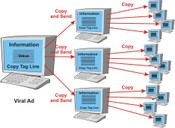Viral Marketing
The premise of viral marketing is that people will enjoy an advertisement so much they will not only watch it but be willing to pass it along to several other people they know.
The rise of the internet, email and social networking sites have made viral marketing an easy, cheap and highly seductive new tool for marketers. The recipe is simple. Identify individuals with high social networking potential, deliver your message to them, have them tell two or more friends and let the viral process begin.
But does it really work? Is it an effective way to build or maintain brands?
Not in my opinion.
And not according to the reseach. A recent study by JupiterResearch found that only 15 percent of campaigns achieved the goal of having consumers pass along the brand message. Not very successful at all.
Some messages do spread wildly over the internet like The Subservient Chicken for Burger King. But did the chicken campaign help the Burger King brand? I don’t think so. Kids thought the chicken was cool, but it didn’t lead them to talk about or chow down those Burger King chicken sandwiches.
The problems with viral marketing are the same problems facing traditional advertising.
1. Consumers don’t like advertising.
Advertising is not something consumers like or generally want. When they can, they avoid it at all costs (with TiVo, pop-up blockers, spam filters, no-call lists etc.)
Consumers are very sensitive and suspicious of companies sending messages to them because advertising lacks credibility. Advertising is self-serving one-way message which is why advertising works best to remind people of something they already know rather than to try and tell people something new.
When the internet was new, every email message you received was exciting. “You’ve Got Mail!”
When television was new, it was the same thing. Any program or advertisement on television was exciting to watch.
But the internet is not new anymore. Most people dread checking their inbox because finding the important stuff is going to be difficult since there is so much bad stuff (AKA spam or advertising). We now have spam filters, blockers and all sorts of contraptions to weed out the bad stuff, something unheard of in the early days of the net.
2. Too much focus on creativity.
Getting the attention of consumers is tough so most viral campaigns are built on jokes or gimmicks. Jokes and gimmicks don’t build brands. Ideas build brands. But people don’t pass along ads with just an idea, even if it is a great idea. Where is the credibility or fun in that?
In order to boost consumer involvement, viral marketing agencies (like regular advertising agencies) have focused on creativity with mainly humorous and outrageous concepts to gain attention. But like funny commercials where nobody remembers the advertiser, funny viral marketing campaigns face the same fate.
They might be funny but they usually have no relevance or connection to the brand. Monk-E-Mail has nothing to do with finding a job. Unless you are a monkey.
It is the catch-22 of viral marketing. Nobody is going to pass along a pure advertisement to friends and family. But the funny or gimmick message they are likely to pass along is usually devoid of any true brand message.
A powerful gimmick is an oxymoron. And viral marketing is a gimmick.
Of course, not every viral campaign is a waste of time. A few campaigns do make sense, but it is only on the rare occasion where you have a known brand and the gimmick has real significance to the brand and delivers a message. Much like powerful traditional advertising is created when you reinforce an already embedded idea, viral advertising is the same.
HBO’s Whack-A-Soprano takes the core of the brand and uses a gimmick to entertain fans. It would not have worked with a show and cast nobody had ever heard of.
What does work to build brands?
Word-of-mouth generated by a legitimate idea or message is what builds brands. And the best way to get high-quality word-of-mouth started is with PR.
High-quality means people talk about your brand not just your advertisement.
The Pets.com sock puppet, the Taco Bell Chihuahua or the Burger King Subservient Chicken were all low-quality gimmicks. Consumers only talked about the ads not the brands.
The difference between viral marketing or advertising and PR is the third party effect. Viral marketing or advertising is a message from the advertiser. PR is a message from a third-party. Not you saying you are great, somebody else saying you are great.
The credibility of having a third party endorse your brand is what builds the brand. If you are thinking “I can’t get any PR for my brand, I need to do something like viral marketing or advertising to build my brand” you are in big trouble. Because if you are having trouble getting PR, then what you have is a branding problem. You brand is not relevant, is a copy-cat, has the wrong name or something else is wrong.
Consumers are much more likely to forward an interesting PR story to friends and family than an advertisement. Why? The third-party factor.
I am not passing on a self-serving message from a company. I am passing along an endorsement by the Wall Street Journal about a product. Big difference.
 ?>
?>
